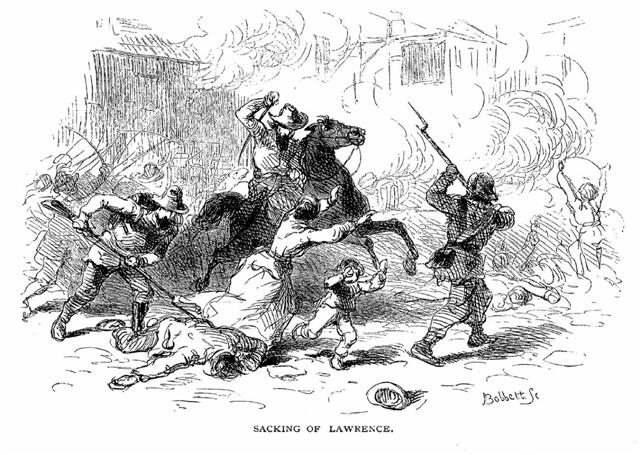Events in Missouri and Arkansas
- A thousand miles westward of the
sea-coast the war was still going on, but more feebly than at first. The
Confederates reoccupied all Texas in 1863, and carried on a sort of guerrilla
warfare in Arkansas and Missouri during a part of that year. In the earlier
months, Marmaduke was active with his mounted men. He rushed over the border
from Arkansas into Missouri, and fell upon Springfield in January, but was
repulsed with a loss of two hundred men. After some other reverses, he fell
back; and at Little Rock, the capital of Arkansas, he planned a formidable
raid into Missouri, chiefly for the purpose of seizing National stores at Cape
Girardeau, on the Mississippi. He invaded the State with eight thousand men,
and was met at the Cape by General McNeil, on the 20th of April, who, after a
sharp engagement, drove Marmaduke out of Missouri.

- Other bands of Confederates, under various leaders, roamed
over the western borders of Arkansas, and, at one time, seriously menaced Fort
Blunt, in the Indian Territory. There was a sharp engagement at Honey Springs,
in that Territory, on the I7th of July, between Nationals under General Blunt
and Confederates in strong force led by General Cooper, in which the latter
were defeated, and a part of them fled into northern Texas. Guerrilla bands in
Blunt's rear did much mischief. One of them, led by a white savage named
Quantrell, fell upon the defenceless town of Lawrence, in Kansas, on the 13th
of August, and murdered one hundred and forty of the inhabitants. They also
laid one hundred and eighty-five buildings in ashes and escaped.
- Earlier than this, the strongly
fortified post of Helena, on the Mississippi, in eastern Arkansas, became a
coveted object; and on the 3d of July (1863) eight thousand Confederates,
under General Price and others, ignorant of the strength of the post, attacked
it. General Steele was in command there. After a sharp fight, the Confederates
were repulsed with a loss of twenty per cent of their number. That section of
Arkansas was then abandoned by the Confederates; and on the 10th of August,
Steele left Helena with twelve thousand troops and forty pieces of cannon, to
attempt the capture of Little Rock. He pushed back Marmaduke, who confronted
him; and early in September he moved on the State capital in two columns, one
on each side of the Arkansas River. The Confederates there, after setting fire
to several steamboats, abandoned the place on the evening of the 10th
(September) and fled to Arkadelphia, on the Wachita River. Meanwhile General
Blunt had been trying to bring the Confederates and their Indian allies in
western Arkansas to battle, but had failed. He took possession of Fort Smith
(September 1) and garrisoned it; and on the 4th of October, while he was on
his way from Kansas to that post with an escort of one hundred cavalry, they
were attacked near Baxter's Springs, on the Cherokee Reservation, and
scattered, by six hundred guerrillas led by the notorious Quantrell, who
plundered and burnt the accompanying train of the Nationals. Blunt's forces
were nearly all killed or disabled in the conflict. The wounded were murdered;
and Blunt and only about a dozen followers barely escaped, with their lives,
to Little Fort Blair. Some of Blunt's escort fled, at first, without firing a
shot. Had they acted more bravely, they could have driven their assailants in
ten minutes, Blunt declared.
- Finding their supplies nearly exhausted,
the Confederates in that region made a raid into Missouri as far as
Booneville, at the close of September; but they were driven back into Arkansas
by Generals E. B. Brown and McNeil. No other military movements of much
importance occurred in Missouri and Arkansas for some time after this,
excepting an attack made by Marmaduke upon Pine Bluff, on the Arkansas River,
on the 25th of October, 1863. The little garrison there was commanded by
Colonel Powell Clayton, and these, with the assistance of two hundred negroes
in making barricades, fought the assailants (who were two thousand strong,
with twelve pieces of artillery) for several hours, and drove them away. Quiet
prevailed for some time afterward.
- When General Banks left Alexandria, on
the Red River, and marched to the siege of Port Hudson, General Taylor, whom
he had driven into the wilds of western Louisiana, returned, occupied that
abandoned city and Opelousas, and garrisoned Fort de Russy. Then he swept
vigorously over the country in the direction of the Mississippi River and New
Orleans. With a part of his command he captured Brashear City on the 24th of
June (1863), with an immense amount of public property, and made a thousand
National troops prisoners. At about the same time another portion of the
Confederates, under General Green, operating in the vicinity of
Donaldsonville, on the Mississippi, were driven out of the district. Finally,
at the middle of July, when Banks's troops were released, on the fall of Port
Hudson, they expelled Taylor and his forces from the country eastward of the
Atchafalaya. This was the last struggle of Taylor's forces to gain a foothold
on the Mississippi.
Lossing, Benson. J., Our
country. A household history for all readers, from the discovery of America to
the one hundredth anniversary of the Declaration of Independence.
With illustrations by Felix O. C. Darley; Johnson & Miles, New York, 1878
 visits since 12/22/2003.
visits since 12/22/2003.
Page updated
05/25/2006


visits since 12/22/2003.